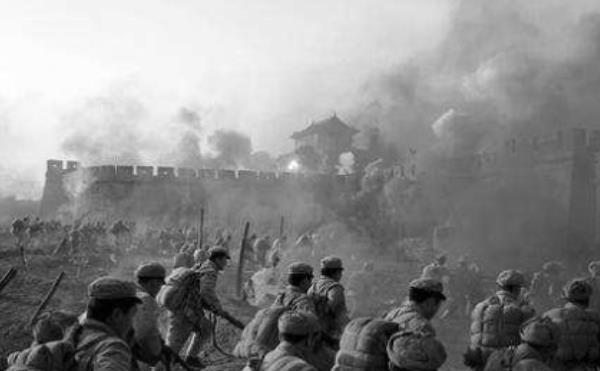During the Liberation War, both the Northeast Field Army and the East China Field Army showed great offensive capabilities, the former successively winning the Liaoshen Campaign and the Pingjin Campaign, from the Baishan Mountains and Black Waters to the ends of the earth; the latter first completely annihilated the Nationalist Army's number one ace, the reorganized 74th Division, and then in the Huaihai Campaign, it destroyed 800,000 enemies with 600,000 troops, almost wiping out the elite of Lao Jiang's concubines. Both field armies made great contributions to the victory of the Liberation War, so who has the better offensive ability than Dongye and Huaye? These two battles are touchstones.

When the War of Liberation was carried out in 1948, although our army seized many small and medium-sized cities occupied by the Nationalist army, it had not yet captured the large cities heavily fortified by the enemy army. At that time, the Northeast Field Army surrounded Changchun, and the East China Field Army isolated Jinan. Both cities had more than 100,000 enemy troops, the former was the capital of puppet Manchukuo, and the latter was the capital of Shandong, and their strategic position was very important. So should we fight Changchun or Jinan first?
Under the circumstances at that time, the conditions for attacking Changchun were much better than attacking Jinan. Although Changchun has 100,000 troops stationed, the main force is only the New 7th Army and the 60th Army, and the remaining 40,000 or so people are security forces with extremely low combat effectiveness. Moreover, although the New 7th Army was Chen Cheng's concubine unit, it was expanded on the basis of the new 38th Division of the New First Army, and among the three divisions under its jurisdiction, the Provisional 56th Division and the Provisional 61st Division were all reorganized from local units, and their combat effectiveness was very limited.
The 60th Army was the Dian Army, which was sent to the northeast battlefield and was ostracized everywhere, fighting in the front and retreating in the rear, and the treatment was incomparable with the Central Army. It was precisely because of the long-term injustice that Pan Shuoduan, commander of the 184th Division, revolted in Haicheng. After the Pan Shuoduan uprising, the 60th Army became a destabilizing factor in the eyes of Lao Jiang, and he asked Mao Renfeng to send many agents to monitor the senior generals of the 60th Army, which caused serious dissatisfaction among the 60th Army, and the commander Zeng Zesheng also had the idea of uprising.
What was more serious was that Changchun at that time had become a veritable isolated city, all the land routes for external contact had been cut off by the Northeast Field Army, and supplies could only be solved by air transport, which was tantamount to a drop in the bucket for the 100,000 defenders. At the same time, the Northeast Field Army had an absolute superiority in strength and firepower, and at that time, there were nearly 700 heavy artillery pieces in the East Field alone. All these favorable conditions added up, and the head of Dongye was full of confidence in taking Changchun and reported the battle plan to the Central Military Commission.
In the end, Chairman Mao agreed to Dongye's plan to fight Changchun, and pointed out that "the victory of Changchun will open the way for you to fight in the south one by one to conquer the big cities one by one, and the conquest of each big city will gain experience from the Changchun Campaign." It is not difficult to see from this that Chairman Mao regarded the Changchun Campaign as a pilot project for conquering the big cities of the Nationalist Army in the future, and placed high expectations on it. Subsequently, the Dongye army began to attack Changchun, although it destroyed some of the enemy troops and occupied the dafang airfield, but when attacking the city, it was met with stubborn resistance from the defenders and failed to take Changchun.
After this battle, the chief of Dongye believed that the strong attack on Changchun would be "costly", and there was no absolute certainty, so he changed the siege to a siege, besieging Changchun for more than 4 months, until the end of October 1948, when Changchun was liberated. Dongye failed to lay changchun as planned, and Chairman Mao decided to entrust Huaye with the problem of conquering the big city. In mid-July 1948, he telephoned Chen Su several times, pointing out that "if Jinan can be conquered in August and September, then Xu (Shiyou) and Tan (Zhenlin) can go south in October to cooperate with Li (Yu), Chen (Shiyu), Wei (Guoqing), and Ji (Luo) to fight several major battles and strive to capture Xuzhou in winter and spring."
Compared with playing Changchun, it is much more difficult to fight Jinan. Changchun is a truly isolated city, there is no wait for reinforcements, the Dongye siege troops have no worries; but Wang Yaowu of Jinan can get the support of Xuzhou direction, and old Jiang also promised him that as long as the People's Liberation Army attacks Jinan, he will personally command the three mobile corps in Xuzhou to reinforce, which is a big threat to our siege troops. Because of this, Hua Ye had to allocate most of his troops to help, and the siege force was only 140,000, only 30,000 more than the enemy troops defending the city.
In the end, Huaye took Jinan in only eight days and nights, which was much more efficient than Dongye's liberation of Changchun. From this point of view, in terms of the ability to attack strong points alone, Huaye is higher than Higashino. During the Liberation War, both Dongye and Huaye were the absolute main forces of our army, and both made great contributions to the victory of the Liberation War, and their exploits will forever be recorded in the annals of history.